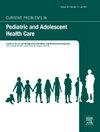超越抑郁和焦虑在儿科初级保健:当前的见解从协作护理模式。
IF 3.7
4区 医学
Q1 PEDIATRICS
Current Problems in Pediatric and Adolescent Health Care
Pub Date : 2025-02-01
DOI:10.1016/j.cppeds.2025.101734
引用次数: 0
摘要
协作护理被广泛接受为一种基于证据的模式来管理儿童初级保健中的抑郁和焦虑。然而,注意缺陷多动障碍(ADHD)、创伤性应激和悲伤的症状在初级保健中很常见,也可以由儿科医生识别并在该模型中进行治疗。注意缺陷多动障碍(ADHD)是最常见的儿童期发病的神经发育障碍,患病率为10.2%创伤谱系障碍是另一类疾病,通常首先由儿科医生发现,也可能只有儿科医生才会发现。在一些城市的儿科中心,遭受过创伤性事件的儿童比例高达90%同样,悲伤的症状通常首先由儿科医生确定。考虑到仅2019冠状病毒病大流行就导致美国儿童的父母、被监护的祖父母和其他照顾者死亡760,000人,受创伤和损失影响的儿童和青少年的数量超出了精神卫生保健系统的能力。鉴于美国儿童和青少年精神科医生的短缺以及对心理健康服务需求的增加,扩大儿科合作护理倡议的范围至关重要。本文分享了在纽约市安全网医院中心实施的合作护理模式的见解,以说明如何在儿科初级保健中识别和管理ADHD,创伤性压力和悲伤。最后,我们将讨论合作护理模式的潜力,以增加移民家庭获得护理的机会。本文章由计算机程序翻译,如有差异,请以英文原文为准。
Beyond depression and anxiety in pediatric primary care: Current insights from the collaborative care model
Collaborative Care is well accepted as an evidence-based model to manage depression and anxiety in pediatric primary care. However, symptoms of attention-deficit hyperactivity disorder (ADHD), traumatic stress, and grief are common in primary care and can also be identified by pediatricians and treated within this model. Attention-deficit hyperactivity disorder (ADHD) is the most common childhood-onset neurodevelopmental disorder with a prevalence of 10.2 %.1 Trauma-spectrum disorders are another cluster of disorders that will often be seen first by the pediatrician, and, potentially, only by the pediatrician. In some urban pediatric centers, the rate of children who have been exposed to traumatic events is as high as 90 %.2 Similarly, symptoms of grief are often first identified by the pediatrician. Considering that the COVID-19 pandemic alone has claimed >760,000 parents, custodial grandparents, and other caregivers to children in the US, the number of children and teenagers affected by trauma and loss overwhelms the mental health care system's capacity. In light of the shortage of child and adolescent psychiatrists in the United States and the increased demand for mental health services, it is essential to broaden the scope of what collaborative care initiatives can accomplish in pediatrics. This paper shares insights from a collaborative care model implemented in a New York City safety net hospital center to illustrate how ADHD, traumatic stress, and grief can be identified and managed in pediatric primary care. Lastly, we will discuss the potential for collaborative care models to increase access to care for immigrant families.
求助全文
通过发布文献求助,成功后即可免费获取论文全文。
去求助
来源期刊
CiteScore
4.60
自引率
0.00%
发文量
61
审稿时长
5 days
期刊介绍:
Recognized for its probing, comprehensive, and evidence-based reviews, Current Problems in Pediatric and Adolescent Health Care devotes each issue to a timely and practical topic in pediatric medicine, presented by leading authorities in the field. The journal offers readers easily accessible information that enhances professional experience and is pertinent to daily pediatric practice. Each issue''s review article is accompanied by an additional special feature designed to highlight a particular aspect of the topic presented.

 求助内容:
求助内容: 应助结果提醒方式:
应助结果提醒方式:


